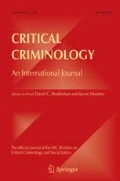Abstract
The presence of discarded metals in the back alleys of cities is a ubiquitous feature of contemporary urban life. To many, this metal is waste to be forgotten. To some, it is the basis of scrounging to survive. Based on a qualitative content analysis of news reports, we reflect on media framing of scrap metal collection in Winnipeg, Manitoba, Canada. Our analysis reveals that news media adopt a crime frame to depict metal collecting that emphasizes dangerousness and destruction of culture and history, while individualizing the actions of collectors and ignoring questions of urban poverty, racism and other contextual factors linked to crime. We contrast media representations with data from interviews with local scrappers and observations of the scrap metal industry in Winnipeg to illustrate what is absent in this media framing. We also reflect on the conundrums apparent with proposed metal crime regulations.

Similar content being viewed by others
Notes
While the moral panic framework (Cohen 1972) has been used to analyze overblown mediated reactions to relatively harmless criminal activity and social deviance, we do not find compelling analytical reasons to warrant the application of this model in our analysis of media framing of scrap metal collection as crime. Indeed, we note a number of key conceptual weaknesses in the moral panic framework that makes its application fraught in our analysis. For example, Garland (2008) points out several, including the issue of proportionality (how can we know if there is truly an overreaction?), the symptomatic, sublimated character of the panic reaction (it is not really about “this,” but about something else at much deeper, subconscious level), and the idea of consensus (is there a moral panic if there is no broad societal agreement about the nature of the problem and the need for urgent action?). Consequently, we find the signal crimes perspective a more analytically useful conceptual tool to interrogate the mediated construction of scrap metal collection as crime and its broader cultural significance in the local community.
A notable feature of news media reporting of scrap metal crime is the frequent use of a humorous or ironic rhetorical framing. In fact, eighteen news items drew on humor or irony as a primary or secondary framing device. For example, one story reported that a dump in a small town was a frequent target of break-ins. Officials wryly noted that the metal thieves could help themselves to anything in the dump, but they needed to visit during regular business hours rather than the middle of the night (Brandon Sun, December 18, 2017, “Hartney landfill break-ins upset Reeve”). Similarly, a story noted the irony of a British courthouse falling victim to metal theft (Globe and Mail, October 26, 2007, “Irony abounds as bold-as-brass metal thieves strip U.K. courthouse roof”).
CBC Manitoba reported the theft of several metal objects from an inner-city little league baseball team, including aluminum bats and plumbing fixtures (CBC Manitoba, October 22, 2018, “Thieves swipe metal equipment, even water tap, during break-in at Elmwood Giants Field”). Another story in the Portage Daily Graphic reported the theft of aluminum goalposts from community sports fields in the greater Vancouver area (Portage Daily Graphic, January 30, 2003, “Thieves Steal Aluminum Goalposts For Scrap”).
It was reported that Habitat for Humanity had been victimized repeatedly by theft of building materials to the point where a spokesperson lamented that crime was “killing” the organization (CBC Manitoba, September 21, 2018, “Spike in thefts at Habitat for Humanity sites ‘killing us,’ charity says”).
References
Altheide, D. (1987). Ethnographic content analysis. Qualitative Sociology, 10(1), 65–77.
Altheide, D. (1997). The news media, the problem frame, and the production of fear. Sociological Quarterly, 38(4), 647–668.
Ashby, M. (2016). Is metal theft committed by organized crime groups, and why does it matter? Criminology and Criminal Justice, 16(2), 141–157.
Ashby, M., & Bowers, K. (2015). Concentrations of railway metal theft and the locations of scrap-metal dealers. Applied Geography, 63(September), 283–291.
Ashby, M., Bowers, K., Borrion, H., & Fujiyama, T. (2017). The when and where of an emerging crime type: The example of metal theft from the railway network of great britain. Security Journal, 30(1), 1–23.
Barker, A. (2014). Communicating security? Policing urban spaces and control signals. Urban Studies, 51(14), 3046–3061.
Bennett, L. (2008). Assets under attack: Metal theft, the built environment and the dark side of the global recycling market. Environmental Law and Management, 20(4), 176–183.
Best, J. (1987). Rhetoric in claims-making: Constructing the missing children problem. Social Problems, 34(2), 101–121.
Best, J. (1990). Threatened children: Rhetoric and concern about child-victims. Chicago, IL: University of Chicago Press.
Brabenec, T., & Montag, J. (2018). Criminals and the price system: Evidence from Czech metal thieves. Journal of Quantitative Criminology, 34(2), 397–430.
Brisman, A. (2010). The indiscriminate criminalisation of environmentally beneficial activities. In R. White (Ed.), Global environmental harm: Criminological perspectives (pp. 161–192). Cullompton, Devon, UK: Willan.
Buckland, J., Guenther, B., Boichev, G., Geddie, H., & Mutch, M. (2005). “There are no banks here”: Financial and insurance exclusion in Winnipeg’s North End. Winnipeg inner-city research alliance. Retrieved on February 20, 2020, from http://hdl.handle.net/10680/373.
Canadian Electricity Association. (2014). Copper theft from Canada’s electricity infrastructure: Dangerous, expensive and a threat to reliability. Ottawa, ON. Retrieved on August 13, 2020, from https://electricity.ca/wp-content/uploads/2017/05/CopperTheft-1.pdf.
Christie, N. (1986). The ideal victim. In E. Fattah (Ed.), From crime policy to victim policy (pp. 17–30). London: Palgrave Macmillan.
Cohen, S. (1972). Folk devils and moral panics: The creation of the mods and rockers. London: MacGibbon & Kee.
Depken, C., II, & Stephenson, F. (2017). Copper theft in the United States: 2006–2013. The American Economist, 62(1), 66–76.
Edensor, T. (2005). Waste matter: The debris of industrial ruins and the disordering of the material world. Journal of Material Culture, 10(3), 311–332.
Ferrell, J. (2006). Empire of scrounge: Inside the urban underground of dumpster diving, trash picking, and street scavenging. New York: NYU Press.
Garland, D. (2001). The culture of control: Crime and social order in contemporary society. Chicago, IL: University of Chicago Press.
Garland, D. (2008). On the concept of moral panic. Crime Media Culture, 4(1), 9–30.
Girling, E., Loader, I., & Sparks, R. (2000). Crime and social change in middle England: Questions of order in an English town. London: Routledge.
Hepburn, A. (2013). Copper theft: A worldwide, and sometimes lethal, epidemic. Why are so many people stealing the stuff? MacLean’s. Retrieved on January 15, 2019, from https://www.macleans.ca/economy/business/copper-theft-a-worldwide-and-sometimes-lethal-epidemic.
Hinman, D. (1975). Combating copper theft. Security Management, 18(6), 14–17.
Innes, M. (2003). Signal crimes: Detective work, mass media and constructing collective memory. In P. Mason (Ed.), Criminal visions: Media representations of crime and justice (pp. 51–69). Portland, OR: Willan.
Innes, M. (2004). Signal crimes and signal disorders: Notes on deviance as communicative action. The British Journal of Sociology, 55(3), 335–355.
Innes, M., & Fielding, N. (2002). From community to communicative policing: ‘Signal Crimes’ and the problem of public reassurance. Sociological Research Online, 7(2), 56–67. https://doi.org/10.5153/sro.724.
Jewkes, Y. (2011). Media and crime (2nd ed.). London: Sage.
Kerr, J. (2018). The state of heritage and cultural property policing in England and Wales, France and Italy. European Journal of Criminology. https://doi.org/10.1177/1477370818803047.
Kohm, S. A. (2020). Claims-making, child saving, and the news media. Crime Media Culture, 16(1), 115–137. https://doi.org/10.1177/1741659019838003.
Kooi, B. (2010). Theft of scrap metal. Problem oriented policing guides for police #58. Washington DC: Office of Community Oriented Policing Services. Retrieved on September 3, 2020, from https://popcenter.asu.edu/content/theft-scrap-metal-0.
Kort-Butler, L. A., & Habecker, P. (2018). Framing and cultivating the story of crime. Criminal Justice Review, 43(2), 127–146.
Kozlowski, J. (2008). Lifting heavy metal. Law Enforcement Technology, 35(10), 40–45.
Lule, J. (2004). War and its metaphors: News language and the prelude to war in Iraq, 2003. Journalism Studies, 5(2), 179–190.
Mares, D., & Blackburn, E. (2017). Reducing metal thefts through the use of local ordinances: An evaluation of an impromptu market reduction approach in St. Louis, MO. Security Journal, 30(2), 487–503.
Mitchell, D., & Heynen, N. (2009). The geography of survival and the right to the city: Speculations on surveillance, legal innovation, and the criminalization of intervention. Urban Geography, 30(6), 611–632.
Monahan, T. (2017). Regulating belonging: Surveillance, inequality, and the cultural production of abjection. Journal of Cultural Economy, 10(2), 191–206.
Müller, T. (2012). The empire of scrounge meets the Warm City: Danger, civility, cooperation and community among strangers in the urban public world. Critical Criminology: An International Journal, 20(4), 447–461. https://doi.org/10.1007/s10612-012-9160-5.
Parnaby, P. (2003). Disaster through Dirty Windshields: Law, order and toronto’s squeegee kids. Canadian Journal of Sociology, 28(3), 281–307.
Posick, C., Rocque, M., Whiteacre, K., & Mazeika, D. (2012). Examining metal theft in context: An opportunity theory approach. Justice Research and Policy, 14(2), 79–102.
Price, V., Sidebottom, A., & Tilley, N. (2014). Understanding and preventing lead theft from churches: A script analysis. In L. Grove & T. Suzie (Eds.), Heritage crime (pp. 128–148). London: Palgrave Macmillan.
Roach, J., Alexander, R., & Pease, K. (2012). Signal crimes and signal policing. Police Journal, 85(2), 161–168.
Robb, P., Coupe, T., & Ariel, B. (2015). ‘Solvability’ and detection of metal theft on railway property. European Journal on Criminal Policy and Research, 21(4), 463–484.
Saleh, E. (2016). The master cockroach: Scrap metal and syrian labour in beirut’s informal economy. Contemporary Levant, 1(2), 93–107.
Sidebottom, A., Ashby, M., & Johnson, S. (2014). Copper cable theft: Revisiting the price-theft hypothesis. Journal of Research in Crime and Delinquency, 51(5), 684–700.
Sidebottom, A., Belur, J., Bowers, K., Thompson, L., & Johnson, S. D. (2011). Theft in price-volatile markets: On the relationship between copper price and copper theft. Journal of Research in Crime and Delinquency, 48(3), 396–418.
Stickle, B. (2017). Metal scrappers and thieves: Scavenging for survival and profit. Basingstoke, Hampshire, UK: Palgrave Macmillan.
Surette, R. (2007). Media, crime and criminal justice. Belmont, CA: Thomson/Wadsworth.
Valverde, M. (2006). Law and order: Images, meanings, myths. New Brunswick, NJ: Rutgers University Press.
Walby, K., & Kohm, S. (2020). Metal at urban margins: Regulating scrap metal collecting in Winnipeg, Canada. Canadian Journal of Urban Research, 29(1), 98–111.
Whiteacre, K., Terheide, D., & Biggs, B. (2015). Metal theft and repeat victimization. Crime Prevention and Community Safety, 17(3), 139–155.
Williamson, S. (2018). What’s in the water? How media coverage of corporate genx pollution shapes local understanding of risk. Critical Criminology: An International Journal, 26(2), 289–305.
Zukin, S. (1987). Gentrification: Culture and capital in the urban core. Annual Review of Sociology, 13(1), 129–147.
Author information
Authors and Affiliations
Corresponding author
Ethics declarations
Conflict of interest
The authors declare that they have no conflict of interest.
Research Involving Human Participants
The research project protocol was reviewed and approved by the University of Winnipeg Human Research Ethics Board. Research Office file No. HE11394.
Informed Consent
The research project protocol, including provisions for free and informed consent by all research participants, was reviewed and approved by the University of Winnipeg Human Research Ethics Board. Research Office file No. HE11394.
Additional information
Publisher's Note
Springer Nature remains neutral with regard to jurisdictional claims in published maps and institutional affiliations.
Rights and permissions
About this article
Cite this article
Kohm, S., Walby, K. Local Media Framing of Scrap Metal Collection as Crime. Crit Crim 28, 613–629 (2020). https://doi.org/10.1007/s10612-020-09527-z
Published:
Issue Date:
DOI: https://doi.org/10.1007/s10612-020-09527-z



